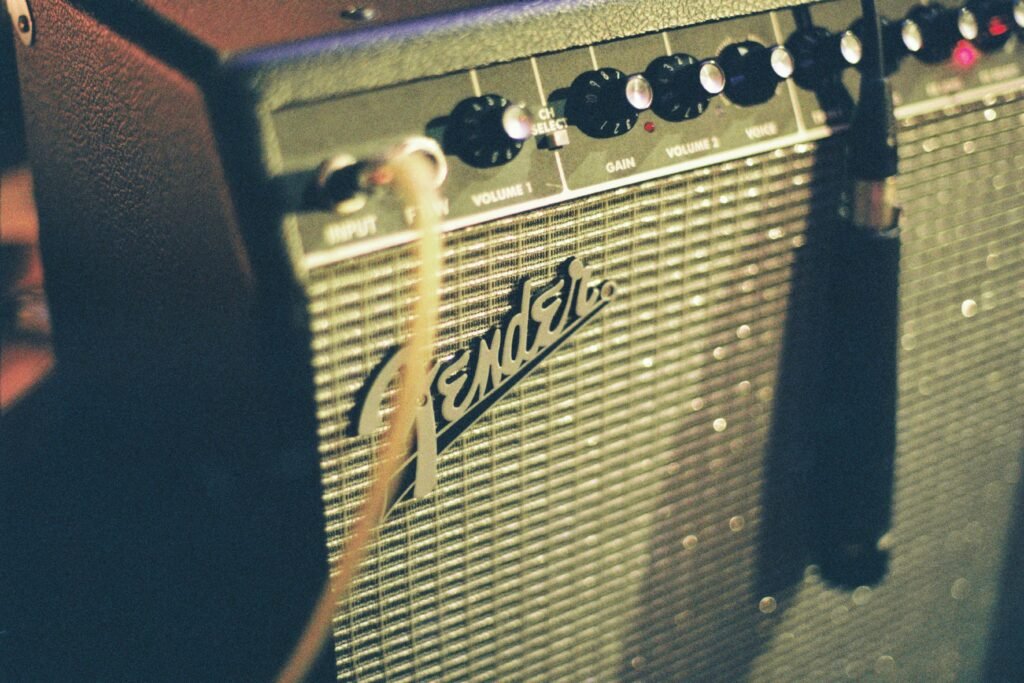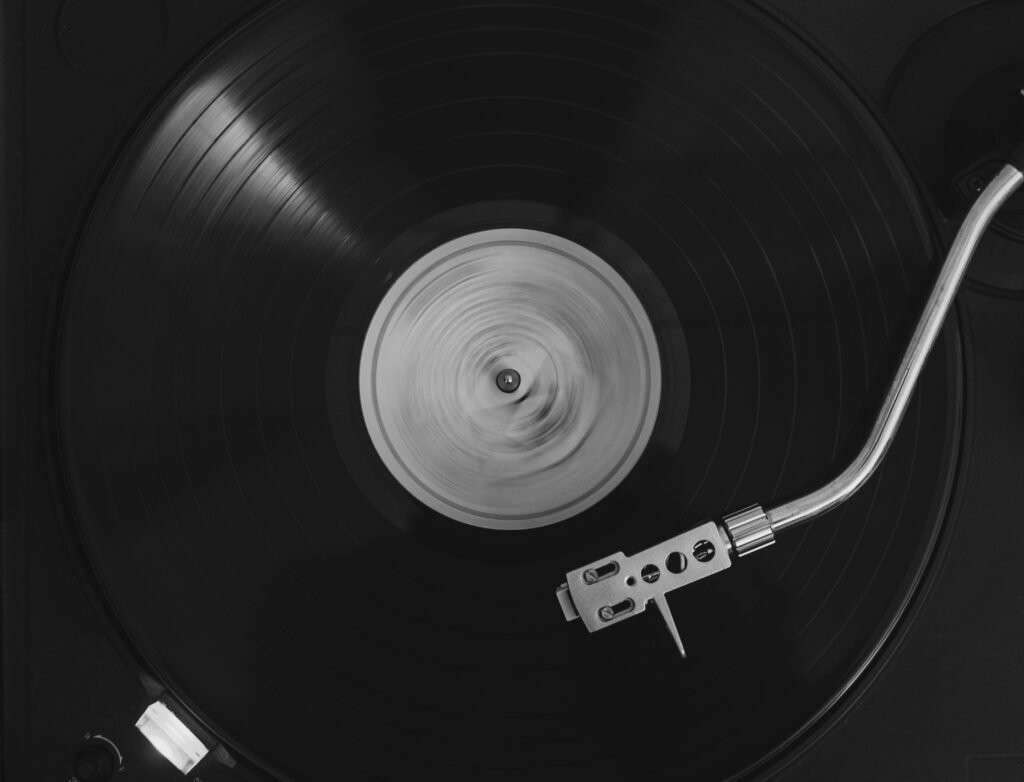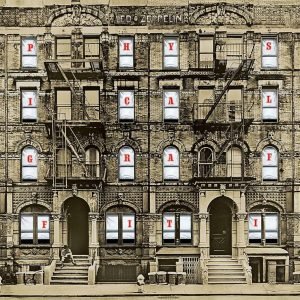Released in 1975, Physical Graffiti is Led Zeppelin’s sprawling, ambitious double album that marked a turning point both in their career and in the music landscape of the 1970s. This sixth studio album arrived at a time when Led Zeppelin had already cemented their legacy with their previous works, from the raw power of their early albums to the expansive, mystical qualities of Led Zeppelin IV and Houses of the Holy. Yet, instead of resting on their laurels, the band sought to push their creative boundaries further, crafting an album that wasn’t just a collection of songs but a comprehensive journey through the different facets of rock music, steeped in eclectic influences and unapologetic excess.
Artistic Intentions
Physical Graffiti captures Led Zeppelin in full command of their artistry and sound, using the double album format to explore a mix of stylistic textures—blues, folk, rock, funk, and even Eastern sounds—that each push against the band’s established boundaries. In a sense, this album is as much a retrospective as it is a leap forward. Several of the tracks, including “Houses of the Holy” and “The Rover,” were originally recorded during prior sessions and shelved, only to be revived and reimagined here. This integration of past and present makes Physical Graffiti both a celebration of their musical journey and an exploration of new territories, encapsulating Zeppelin’s evolution and demonstrating their fearless approach to the creative process.
Jimmy Page, the band’s guitarist and producer, often described Physical Graffiti as Led Zeppelin’s definitive album. It wasn’t just about creating more songs but creating an album that captured the band’s artistic versatility and commitment to authenticity. The album’s artistic vision was rooted in its diversity—a diversity that came from Zeppelin’s refusal to be pinned down by any single genre or style. Instead, the band embraced complexity and contradictions, giving listeners 15 tracks that range from the haunting folk balladry of “Bron-Yr-Aur” to the pounding, epic rock of “Kashmir.”
Sonic Exploration

On Physical Graffiti, Led Zeppelin dives deep into sonic experimentation, constructing a rich tapestry of sounds that highlights their mastery of production and arrangement. Jimmy Page, who produced the album, opted for a meticulous approach to production that emphasizes both clarity and depth, creating a recording that feels vast and immersive without sacrificing raw intensity. The production quality of Physical Graffiti captures the intricacies of each instrument and vocal layer, letting the songs breathe while simultaneously delivering moments of overwhelming sonic power. This balance is key to the album’s impact; the production is clean enough to showcase technical precision yet gritty enough to maintain an organic, visceral energy that complements Zeppelin’s blues-rock roots.
Musical Arrangements
The arrangements on Physical Graffiti reflect Led Zeppelin’s bold approach to songcraft. From Robert Plant’s expressive vocal runs to John Bonham’s thunderous drumming, each member’s performance is intricately woven into the fabric of each track. Page’s guitar work stands out as a driving force across the album, his riffs often forming the backbone of the songs while his solos venture into uncharted sonic territory. Tracks like “In My Time of Dying” exemplify the band’s use of instrumental dynamics, as the song shifts between restrained blues phrases and explosive crescendos.
John Paul Jones, often the underrated architect of Zeppelin’s arrangements, employs bass lines and keyboard textures that provide both stability and unexpected twists, as heard in the layered mystique of “Kashmir.” In fact, “Kashmir” is a defining example of the band’s innovative arrangement style, using an unconventional 3/4 rhythm with exotic chord progressions that evoke a sense of grandeur and mystery, transporting the listener into a sonic landscape as vast as its lyrical themes.
Genre Elements
Genre-blending is one of the defining traits of Physical Graffiti. Led Zeppelin takes their characteristic blues-rock foundation and weaves in threads of folk, funk, hard rock, and Eastern influences, creating a work that feels both familiar and avant-garde. This album doesn’t adhere to a singular genre; rather, it draws from a multitude of styles that coexist without restraint.
“Trampled Under Foot,” for instance, is grounded in a funk-inspired groove that contrasts sharply with the album’s folkier cuts like “Bron-Yr-Aur,” a delicate acoustic piece reminiscent of traditional British folk. Similarly, “In the Light” channels a psychedelic ambience with its use of synthesizers and layered, droning arrangements that build into a hypnotic experience, showcasing the band’s fascination with the meditative qualities of Eastern music.
Lyrical Analysis

The lyrics of Physical Graffiti reveal Led Zeppelin’s fascination with a wide array of themes, from mysticism and existentialism to love and loss, portraying a band unafraid to explore both personal and universal questions. Robert Plant’s writing reaches new heights on this album, pushing beyond the raw romanticism of their earlier work into more introspective, and often enigmatic, territory. A central theme that runs through the album is the idea of a journey—whether physical, spiritual, or emotional.
Tracks like “Kashmir” delve into this notion of an epic voyage, both literal and metaphysical, as Plant’s lyrics evoke a desert pilgrimage through surreal landscapes that represent a search for self-discovery and transcendence. Similarly, “In the Light” speaks to the quest for enlightenment, offering an uplifting message of hope and resilience against adversity.
Recurring motifs of mythology, mysticism, and the supernatural lend a dreamlike quality to the lyrics, a hallmark of Plant’s writing that elevates the album’s narrative scope. For example, “The Rover” reflects on themes of solitude and the quest for meaning in a world that feels fractured and tumultuous. Plant’s lyrics here are reflective and world-weary, embodying a kind of poetic melancholy that suggests both longing and acceptance. This sense of wandering and searching—physically and spiritually—echoes across the album, giving Physical Graffiti a cohesive, almost cinematic quality, as if each song represents a different scene in an overarching epic.
Lyrical Depth
Lyrically, Physical Graffiti is a mix of straightforward storytelling and abstract, evocative poetry. Tracks like “Ten Years Gone” take a more narrative approach, reflecting on lost love with a vulnerability that contrasts with the album’s bolder, mythic songs. Here, Plant’s lyrics are deeply personal, recalling memories of youthful romance with a poignant sense of nostalgia, underscoring the inevitable passage of time and the bittersweet nature of change. Meanwhile, “In My Time of Dying” draws on traditional blues imagery, with lyrics that are less specific but heavy with symbolic weight, touching on mortality and the desire for redemption. In this blues-rock reimagining of a gospel standard, the lyrics capture a primal sense of desperation, as if grappling with mortality head-on.
Emotional Impact
Emotionally, the lyrics of Physical Graffiti amplify the album’s impact by evoking a wide spectrum of feelings—nostalgia, wonder, isolation, and existential yearning. The lyrics on “Kashmir” evoke awe and contemplation, urging listeners to consider their place within the larger universe, while “Ten Years Gone” taps into a universal experience of longing and loss that resonates on a deeply personal level. Even the darker themes, such as the reckoning with mortality in “In My Time of Dying,” evoke empathy rather than despair, as if Plant’s storytelling guides the listener through these emotions with a sense of shared humanity.
Cohesion and Flow

Physical Graffiti is an album that both challenges and rewards the listener’s sense of cohesion. As a double LP, it covers a sweeping range of styles and themes, yet each track feels intentionally placed, contributing to an overarching experience that captures the spirit of Led Zeppelin at their most ambitious. The album’s flow is meticulously crafted, with each song serving as a distinct chapter in a larger sonic narrative. The opening track, “Custard Pie,” kicks things off with a gritty, infectious groove that signals a no-holds-barred journey ahead, immediately drawing the listener into Zeppelin’s dynamic and genre-defying world.
The progression from track to track doesn’t adhere to a strict narrative arc but instead offers an emotional and thematic exploration that ebbs and flows naturally. The more hard-hitting rock tracks like “The Rover” and “Trampled Under Foot” are spaced out with softer, reflective pieces like “Bron-Yr-Aur,” an acoustic instrumental interlude that adds a moment of respite within the album’s sprawling intensity. This strategic placement of contrasting tones keeps the listener engaged, providing peaks and valleys that enhance the sense of journey central to the album’s vision.
A particularly notable aspect of Physical Graffiti’s flow is its ability to balance old and new material, bridging Led Zeppelin’s early sounds with their more evolved musical directions. By incorporating previously unreleased songs from past sessions, such as “Houses of the Holy” and “Boogie with Stu,” alongside newly crafted tracks, the album achieves a unique cohesion that feels both retrospective and forward-looking. Despite these tracks coming from different creative periods, they align seamlessly, creating an impression that each song belongs within the greater mosaic.
Thematic Consistency
In terms of thematic consistency, Physical Graffiti maintains its core themes of exploration, resilience, and self-discovery throughout. The album’s mood and style shift between rock anthems, blues-fueled grooves, and atmospheric ballads, yet these variations serve to reinforce the album’s message rather than detract from it. The listener is guided through different emotional terrains without any jarring transitions, and each genre shift feels like a deliberate expansion of the album’s sonic and thematic scope rather than a departure. Tracks like “Kashmir” and “In the Light” stand as epic, almost meditative pieces that serve as thematic anchors, lending an otherworldly quality that connects the album’s disparate elements.
Standout Tracks and Moments
Within Physical Graffiti, certain tracks and moments shine particularly brightly, encapsulating the depth and innovation that define this album as one of Led Zeppelin’s most revered works. Each of these standout tracks showcases unique aspects of the band’s artistry, from intricate instrumental arrangements to powerful lyrical themes, making them unforgettable components of the double album’s grand architecture.
Kashmir
“Kashmir” is perhaps the most iconic piece on Physical Graffiti, and for good reason. This track stands as an anthem not only for Led Zeppelin but for rock music at large, blending a hypnotic, Eastern-influenced melody with John Bonham’s thunderous drumming and a transcendent string arrangement. It’s a mesmerizing composition that feels almost cinematic, capturing an essence of wanderlust and otherworldly grandeur.
Plant’s lyrics about “the land of ice and snow” evoke images of distant, mystical lands, heightening the song’s epic scope. The interplay between Bonham’s driving beat and Page’s churning guitar riff creates a sense of vastness, echoing the song’s thematic journey. “Kashmir” is more than a rock song; it’s an odyssey that places the listener on an endless horizon, encapsulating the album’s spirit of exploration.
Ten Years Gone
“Ten Years Gone” is another emotional high point, a contemplative and deeply personal track that resonates with nostalgia and introspection. The lyrics, which reflect on the passage of time and the ache of lost love, find new life in the context of Page’s layered guitar work, which alternates between gentle and soaring, mirroring the song’s reflective tone. There’s a subtle complexity in the song’s progression, with each layer gradually unfolding to reveal a heartfelt honesty that captures a universal sense of longing and memory. Plant’s vocals here are tinged with a haunting quality that complements the lyrics, giving listeners a glimpse into a quieter, more vulnerable side of Zeppelin.
Trampled Under Foot
“Trampled Under Foot” serves as one of the album’s most rhythmically infectious tracks, grounding Physical Graffiti with a danceable, funk-infused energy. Built around Jones’ clavinet riff, which is reminiscent of Stevie Wonder’s “Superstition,” the song fuses Zeppelin’s blues roots with a sense of playful, almost manic energy. Bonham’s groove, combined with Page’s gritty guitar riffing, provides a relentless propulsion, making it one of the band’s most groove-heavy songs. It’s a refreshing departure from the album’s more epic and contemplative moments, showcasing Zeppelin’s ability to diversify their sound while still delivering pure rock energy.
In My Time of Dying
Another standout moment comes with “In My Time of Dying,” an electrifying, blues-inspired epic that stretches over 11 minutes, capturing the full intensity of Zeppelin’s instrumental prowess. Inspired by traditional blues yet infused with their own raw power, the track explores themes of mortality and redemption with a blend of aggression and soul. Bonham’s drumming on this track is particularly noteworthy, adding a relentless, primal force that drives the song’s peaks and valleys.
The way the band alternates between haunting quiet sections and explosive bursts creates a sense of high drama that is almost cinematic. As the song reaches its climactic end, Plant’s fervent cries and the band’s frenetic playing seem to teeter on the edge of chaos, leaving an indelible impression.
Bron-Yr-Aur
On the quieter end, “Bron-Yr-Aur” provides a breath of fresh air amid the album’s intensity. This brief acoustic instrumental piece, named after the Welsh cottage where Page and Plant spent time writing, offers a glimpse into their folk influences and their affinity for more delicate, pastoral sounds. Its simple, fingerpicked melody and tranquil mood serve as a moment of reflection, giving listeners a break from the album’s heavier themes and textures.
Artistic Contribution and Innovation

Physical Graffiti occupies a monumental place within rock music and the broader music industry, representing a defining moment in the genre’s evolution. Released at a time when rock was becoming more experimental and indulgent, this album pushed boundaries by embracing the double LP format to showcase an expansive range of sounds and themes.
Led Zeppelin’s decision to release a double album—a rarity and a bold move in the mid-1970s—was an act of artistic daring, allowing them to create a work that defied commercial expectations and industry norms. This breadth gave them the freedom to blend established rock standards with unexplored sonic landscapes, making Physical Graffiti as much an exploration of genre as it was an evolution of their established sound.
Genre
In terms of genre, Physical Graffiti stands as a landmark album that expands the possibilities of hard rock. It draws on blues, folk, funk, progressive rock, and even Eastern music, crafting a record that feels both cohesive and wildly diverse. Tracks like “In My Time of Dying” stay true to Zeppelin’s blues roots while reinventing them with an intensity that borders on theatrical, while “Kashmir” ventures into uncharted territory with its exotic scales, intricate rhythms, and symphonic ambition. By merging these influences, Zeppelin crafted an album that elevated rock from a genre associated with rebellion and youthful energy to a sophisticated art form capable of depth, complexity, and vast emotional range.
Production
One of the album’s most innovative aspects lies in its production quality and approach. Jimmy Page’s production on Physical Graffiti is nothing short of groundbreaking, with each track meticulously crafted to balance the raw energy of live performance with studio precision. Page understood the value of sonic space, using production techniques that allowed instruments to breathe and resonate, creating a sense of dimensionality and scale.
For example, on “Kashmir,” the layers of guitar, strings, and Bonham’s powerful drums are carefully mixed to create a vast soundscape, evoking a cinematic experience that was rare in rock music at the time. This approach to production set a new standard, inspiring artists in both rock and other genres to pursue greater sonic depth and detail in their recordings.
In addition to production, Physical Graffiti’s innovative approach to genre blending helped solidify Led Zeppelin’s legacy as musical pioneers. They didn’t simply layer different genres; they synthesized them into something uniquely their own. “Trampled Under Foot” nods to the funk and soul scenes, with John Paul Jones’ clavinet riff echoing Stevie Wonder, yet it remains firmly grounded in Zeppelin’s rock ethos. “In the Light,” with its droning synthesizer and intricate guitar work, reflects the band’s embrace of psychedelic and progressive influences, creating a meditative yet powerful listening experience. Such genre fluidity was unusual in mainstream rock and represented a shift toward more eclectic musical exploration that would influence countless bands and genres for decades.
Themes
Thematically, Physical Graffiti also pushed boundaries by venturing into existential and philosophical realms rather than focusing solely on the love and rebellion themes prevalent in rock. Songs like “Ten Years Gone” and “In My Time of Dying” reflect a mature, introspective side to Zeppelin, exploring themes of mortality, loss, and self-discovery. This thematic depth elevated Physical Graffiti beyond mere entertainment, positioning it as an album that invites contemplation and connection.
Closing Thoughts

Physical Graffiti stands as a pinnacle of Led Zeppelin’s career and one of the towering achievements of 1970s rock music. Its strengths lie in its fearless ambition, genre-defying innovation, and the masterful musicianship of each band member. Led Zeppelin took the double album format as a challenge to stretch their creative boundaries, crafting a project that feels vast, eclectic, and profound without ever losing its coherence. The album’s ability to balance sonic diversity with thematic unity makes it a truly immersive experience, allowing listeners to explore a spectrum of sounds and emotions, from the bombastic rock of “Trampled Under Foot” to the transcendental beauty of “Kashmir.”
While the album’s length might challenge casual listeners, each track contributes something essential to the album’s overall narrative, and there’s little here that feels indulgent or unnecessary. If anything, the wide-ranging tracks only strengthen the album’s appeal, offering listeners new discoveries with every listen. The sheer scale of Physical Graffiti is part of its charm—it’s an invitation to journey through Zeppelin’s musical universe, one that feels deeply personal and universal at once.
In terms of impact, Physical Graffiti solidified Led Zeppelin as true innovators, pushing rock music beyond established limits and influencing generations of musicians. This album isn’t merely a high point for Zeppelin; it’s a defining statement in rock history, bridging the power of blues, rock, folk, and Eastern influences in a way that few bands have managed. With its timeless appeal, Physical Graffiti remains a touchstone for fans and musicians alike, representing rock music’s potential for both raw intensity and refined artistry.
Official Rating
Given its influence, depth, and near-flawless execution, Physical Graffiti deserves a perfect score. 10/10. This rating reflects not only its standing within Led Zeppelin’s discography but its legacy as a milestone in rock music—an album that set the bar for creativity, production, and musical exploration. It’s a record that has transcended its time, continuing to inspire, challenge, and captivate listeners nearly five decades after its release.
